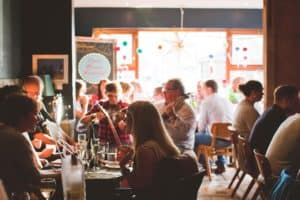Marrakech’s Souks: Navigating the Vibrant Markets Maze
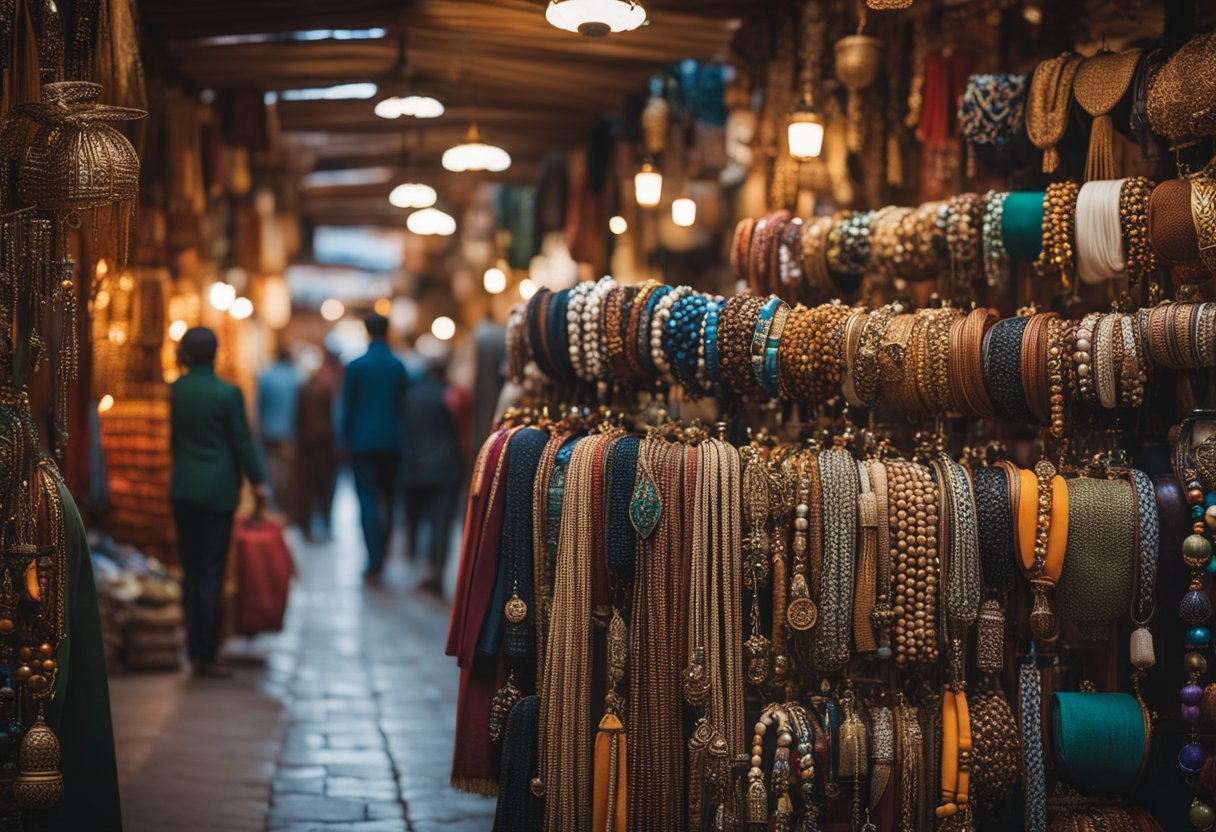
Updated On: April 22, 2024 by Raghda Elsabbagh
Stepping into Marrakech’s souks is like entering a different world, a place where time seems to stand still amid a bustling and vivid tableau of activity. Vibrant colours and enticing aromas waft through the narrow alleyways, drawing us into the heart of the ancient medina. Here, tradition weaves through every stall and workshop, with each souk specialising in its own piece of Moroccan craftsmanship, from the intricate textiles to the handcrafted metalwork.
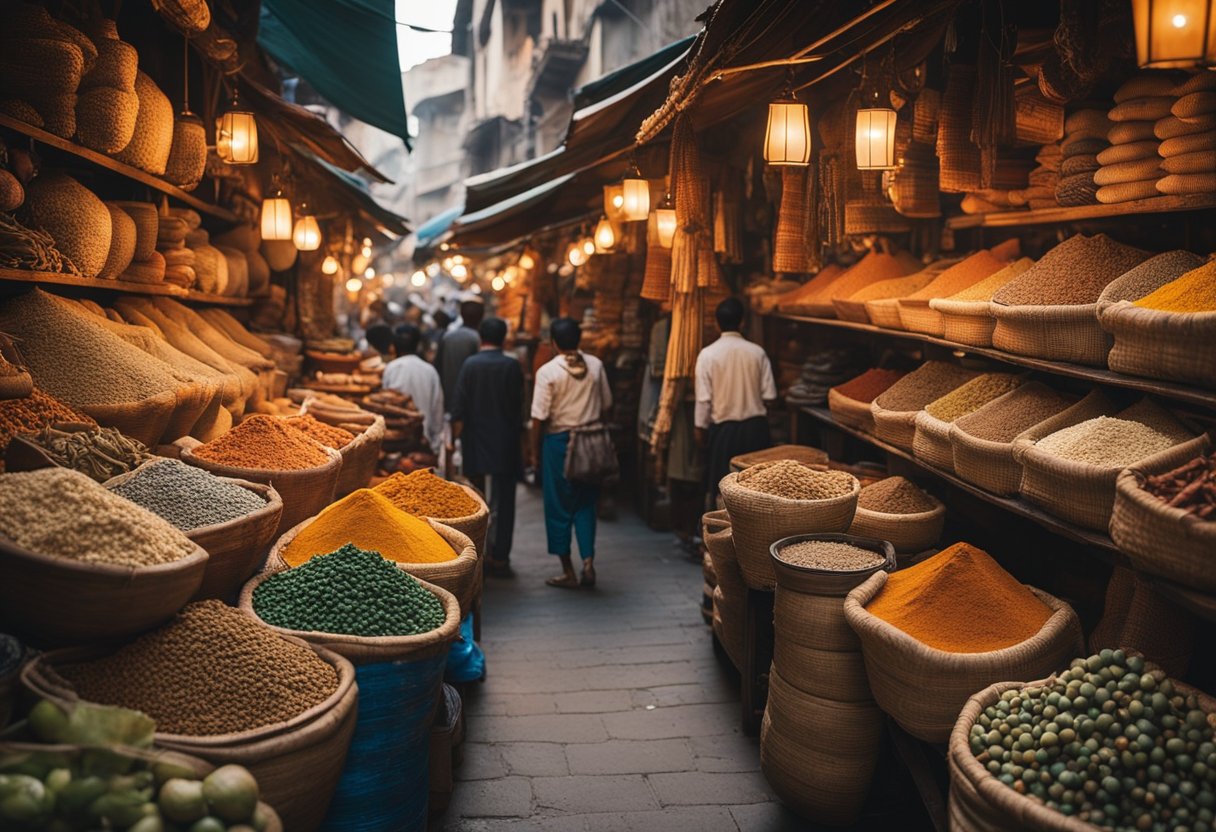
As we navigate through this maze, our senses are engaged by the overflowing stalls of spices, textiles, pottery, and jewellery, each telling a story of Marrakech’s rich cultural tapestry. The art of haggling is central to the souk experience — a dynamic, good-natured exchange that has maintained its place in local commerce for centuries. Immersing ourselves in the bustling market life not only allows us to interact with the city’s heritage but also gives a glimpse into the daily lives of the local artisans and traders.
Table of Contents
Exploring the History of Marrakech’s Souks
Marrakech’s souks reflect a vibrant history, deeply intertwined with the cultural tapestry of the city’s past. From ancient trade connections to its cultural significance, the souks are a living testament to Marrakech’s rich heritage.
The Ancient Trade Roots
Historically, Marrakech has been a pivotal trade hub, with its souks mirroring the ebb and flow of commerce through the ages. Established nearly a millennium ago, the medina of Marrakech was the beating heart of commerce, attracting traders from the desert and beyond. Goods from sub-Saharan Africa, Europe, and the Middle East traversed these ancient routes, converging within the bustling markets. It was here that the foundation of Marrakech’s economic might was laid, with souks serving not merely as places of trade but as crucial zones for cultural exchange and the flourishing of civilisation.
Cultural Significance
Marrakech’s souks are far more than mere market spaces; they are cultural strongholds preserving traditional crafts and skills. Each alley and stall within the market’s cacophony houses a story, a slice of the city’s living history. Over centuries, these markets have become the keepers of Marrakech’s culture, where traditional artisans ply their trade as their ancestors did. The vibrant commerce and social interactions within the souks articulate the cultural significance of Marrakech, underscoring its role as a centre for cultural conservation and continuity. The craftsmanship on display—be it in textiles, pottery or jewellery—reveals age-old techniques passed down through generations, each carrying the imprint of Marrakech’s soul.
Navigating the Medina
In the heart of Marrakech, the Medina presents a captivating challenge for visitors. It’s a sprawling labyrinth, but with a bit of know-how, one can traverse its alleys and markets with confidence.
Orientation and Maps
To begin our journey through the Medina of Marrakech, it’s essential to start with a solid orientation. Maps are a traveller’s best tool in this maze-like environment. While physical maps provide a tangible reference, digital resources can offer up-to-date information and navigation aids. It’s wise to pinpoint landmarks on your map, such as the Koutoubia Mosque, which can serve as a point of reference when wandering the dense network of streets.
Local Guides and Tours
Engaging with a local guide can be invaluable for a deeper understanding of the Medina’s intricate layout. Local guides are adept at navigating the Medina’s complexities and enriching the experience with historical context and cultural insights. Tour options can range from group excursions focusing on Medina’s history to personalised experiences tailored to your specific interests.
The Art of Haggling in Marrakech’s Souks
Haggling is both an art form and a customary trade practice in the bustling Marrakech markets. Our aim is to guide you through this labyrinthine experience with grace and savvy.
Bargaining Etiquette
When we approach stallholders in the Marrakech souks, we’re engaging in a time-honoured tradition of negotiation. It’s crucial to do so with respect and a smile. The initial price offered is rarely final; it’s merely the starting point for bargaining. The traders expect us to counter with a lower offer, but it should be reasonable to avoid offending them.
Tips for Successful Negotiation
- Understand the Value: Before we start, we must have an idea of the item’s worth and the maximum we are willing to pay.
- Remain Calm and Friendly: Good-natured bartering is part of the culture; we maintain our composure and engage with a sense of enjoyment.
- Be Prepared to Walk Away: Sometimes, showing a willingness to walk away may result in the vendor calling us back with a better offer.
- Utilise Local Guides: They can offer invaluable tips and assistance with negotiating.
By embracing the nuances of haggling, we can not only secure fair prices but also participate in a deep-rooted aspect of local culture.
Key Souks and What They Offer
Marrakech’s souks are a feast for the senses, each offering its own speciality. From the buzzing Jemaa el-Fna to the labyrinth of stalls, these markets offer a chance to engage with the city’s rich tradition of craftsmanship.
Souk Semmarine and Leather Goods
Souk Semmarine stands as one of the main arteries in the network of markets. Here, we find a wide array of leather goods, a testament to Marrakech’s thriving leather industry. Patrons can expect to find everything from handcrafted bags to intricately designed belts, all boasting the quality of local artisanal craft.
Jewellery and Metal Crafts
The souks are also home to exquisite jewellery and metal crafts. The intricate work of local jewellers showcases a variety of materials, including silver and brass, which are skilfully transformed into beautiful adornments. Metal lanterns and decor items can be found twinkling in the stalls, ready to add a touch of Marrakech to any home.
Textiles and Fabrics
Lastly, the vibrant world of textiles and fabrics beckons to fashion enthusiasts and interior decorators alike. The souks present a multitude of fabrics, from silks to cotton, along with an abundance of clothing items. The selection is vast and rich with local design and colour, be it kaftans, scarves, or cushion covers.
Traditional Crafts and Workshops
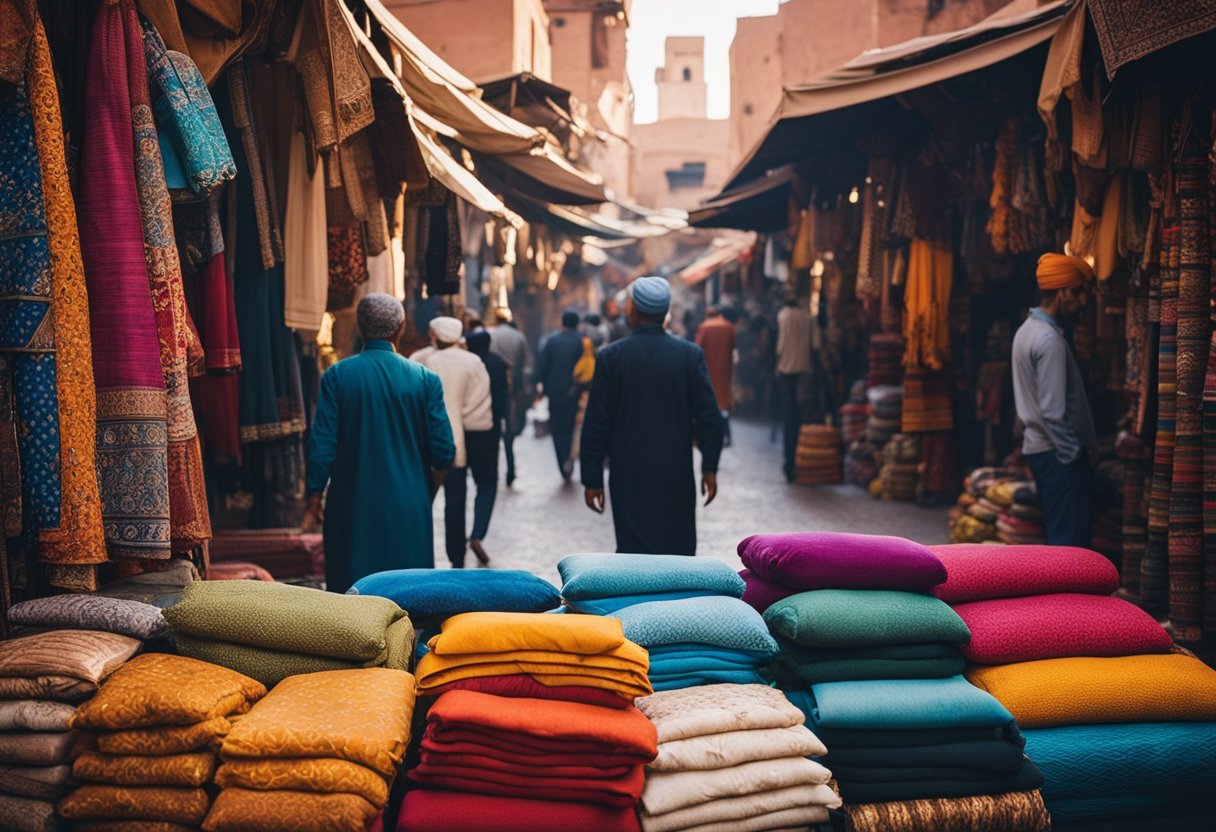
In the heart of Marrakech, the bustling souks not only offer an extravagant shopping experience but also provide insight into traditional Moroccan craftsmanship. Visitors can witness artisans at work, creating intricate handicrafts that reflect the city’s rich cultural heritage.
Carpets and Rugs
Among the labyrinthine alleyways, carpet and rug workshops stand out as a symbol of Moroccan artistry. Here, craftsmen diligently weave, employing age-old techniques to produce patterns and designs that are both culturally significant and aesthetically mesmerising. The process is intricate and time-consuming, with some custom pieces taking months to complete. These textiles are not merely floor coverings but stories woven into the fabric, each thread encapsulating a piece of Moroccan soul. To learn more about the traditional and contemporary designs, delve into how these pieces chronicle Morocco’s history at Navigating the Labyrinth of Marrakech.
Pottery and Ceramics
Turn your attention to the pottery and ceramics district, where the kilns are perennially alight, casting a warm glow on the faces of the dedicated potters. These local workshops produce an array of earthenware, ranging from functional tagines to ornate decorative pieces. The ceramics display a palette of rich ochres, vibrant blues and gleaming whites, often adorned with intricate geometric patterns or Arabic calligraphy. These creations are a testament to the skill and dexterity of Marrakech’s potters, with techniques passed down through generations. Visitors interested in bringing a piece of this craftsmanship home can witness the meticulous art of creating pottery and learn about the diverse ceramic handicrafts at Discover the Vibrant Souks of Marrakech.
Food and Spices in the Souks
In the labyrinthine alleys of Marrakech’s souks, food and spices are a feast for the senses, with vibrant colours and aromatic scents at every turn. Here, one can experience the essence of Moroccan cuisine, a rich tapestry woven from diverse ingredients and flavours.
Fashion, Clothing, and Accessories

We find that Marrakech’s souks offer an abundance of traditional and modern fashion options. The vibrant stalls and boutiques showcase the rich tapestry of Moroccan culture through clothing, jewellery, and leather goods.
Traditional Moroccan Wear
In the heart of the souks, we’re enveloped in the vibrant colours and intricate designs of traditional Moroccan wear. Here, the kaftan reigns supreme; it is not just attire but a statement of cultural identity. These long, flowing garments tailored from luxurious fabrics often feature detailed embroidery and beading. Alongside the kaftans, a variety of hand-woven scarves add a touch of sophistication to the ensemble. Meanwhile, leather belts and hand-crafted jewellery pieces serve as complementary accessories which not only catch the eye but also bear the marks of artisanal skills passed through generations.
Modern Clothing and Bags
Moving through the maze of markets, we uncover a blend of contemporary style with traditional Moroccan craftsmanship. Leather goods are a staple in these parts, with a wide array of bags — from finely crafted satchels to stylish backpacks — available in soft, locally sourced leather. Visitors can also find a mix of modern apparel featuring a Moroccan twist, adding unique patterns and elements to everyday clothing. Leather wallets and ornate jewellery frequently found here provide a modern edge while still paying homage to the intricate design heritage of Marrakech.
Souvenirs and Moroccan Delights
Marrakech’s souks are a treasure trove for those looking to take a piece of Moroccan culture back home. From intricate lanterns to unique cultural keepsakes, the array of souvenirs is vast and evocative of the rich Moroccan heritage.
Lanterns and Home Decor
The craftmanship of Moroccan lanterns is renowned, and their elaborate designs cast mesmerising patterns when illuminated. A stroll through the souks reveals an array of lamps, from hanging lamps to tabletop candlesticks, each capable of transforming a simple room into a haven of Moroccan mystique. These items are more than just decorative; they’re handcrafted stories of Moroccan artisanship, perfect for those in search of authentic home decor.
- Lanterns: Hanging lanterns, standing lamps, wall sconces
- Home Decor: Hand-painted mirrors, woven tapestries, decorative candlesticks
Visiting the Marrakech Guide to Souvenir Shopping the Souks, one will not only find a variety of lamps but also recommendations on how to approach shopping in the bustling market.
Cultural Keepsakes
As one navigates through the maze of stalls, the variety of souvenirs and gifts tells the story of a culture steeped in history. Here, you can find everything from leather-bound journals to intricately designed jewellery boxes, each piece reflecting a facet of Moroccan life. Small trinkets and accessories, such as ornate silver bookmarks or hand-crafted keychains, serve as perfect mementoes of your time spent in the vibrant city.
- Accessories: Leather belts, silver jewellery, handcrafted bags
- Trinkets: Miniature tajine pots, colourful ceramic pieces, traditional Berber jewellery
For detailed insights into what the souks have to offer, a visit to the Shopping guide to the souks of Marrakech, Morocco (with the map!) will provide valuable information on what to expect, aiding any shopping expedition.
Our journey through Marrakech’s souks uncovers the heart of Moroccan craftsmanship and the perfect souvenirs to commemorate your travels. Whether it’s the glow of a new lantern or the charm of a cultural trinket, these delights are sure to keep the spirit of Morocco alive long after you leave.
Practical Tips for Shoppers
In navigating the bustling Marrakech markets, where a sensory overload of sights and sounds awaits, it’s essential to know the best practices for shopping. Here, we share invaluable insights to help you make the most of your souk experience.
Best Times to Visit the Souks
The souks are at their most vibrant in the morning and late afternoon. We advise visiting before midday to avoid the afternoon heat and to catch vendors as they open their stalls or after 4 pm when the cooler air brings the markets back to life. Remember that Fridays might be quieter due to weekly prayers.
Payment Methods and Currency Exchange
Cash is king in the souks, so having Moroccan Dirhams on hand is crucial for transactions. While some vendors may accept credit cards, it’s uncommon. To get the best exchange rates, we recommend using banks or official Bureaux de Change rather than street vendors. Be mindful to carry small denominations to simplify purchases, from intricate silver trinkets to fresh bundles of mint. Always agree on prices in the local currency to avoid confusion.
When it comes to haggling, it’s practically an art form here. Initial prices are often inflated, so don’t shy away from a bit of friendly bargaining. It’s expected and can be quite enjoyable. Just remember to respect the craftsmanship, whether it’s for gold jewellery or an ornately woven carpet, and aim for a price that feels fair to both you and the vendor.
Responsible Tourism and Ethics
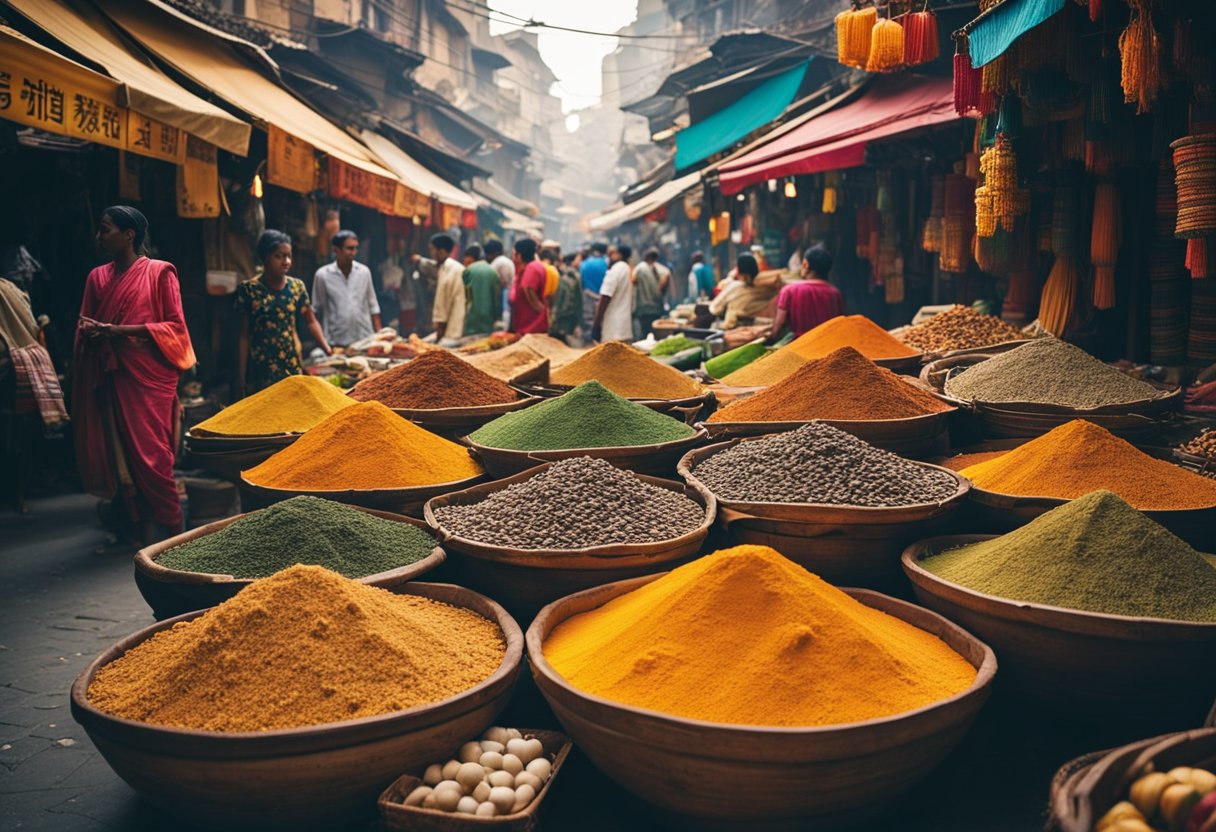
When we visit Marrakech, our approach to tourism can leave a lasting impact on the local community. Ethical shopping is a crucial part of responsible tourism, especially in the souks. These markets are not just a shopping experience; they are the livelihood of local craftsmen. It’s important to recognise the value of their work and pay fair prices.
- Support Local Guides: Employing a local guide not only enhances our tour experience but also contributes to the local economy.
- Understand Local Customs: We make sure to respect local customs and traditions, which helps to foster mutual respect between tourists and residents.
When we think about ethical shopping, it’s about more than just bargaining for a good price. It encompasses recognising the craftsmanship and effort that goes into each product. As visitors:
- We prefer purchasing directly from artisans to ensure they receive fair compensation.
- We look for authentic items that reflect the local culture and heritage.
In terms of responsible tourism, this means:
- Being conscious of our environmental impact and minimising it.
- Engaging with cultural practices responsibly.
We are part of a global movement towards sustainable travel, and every action counts. Marrakech’s vibrant souks are a treasure trove of culture and tradition, and we have a responsibility to preserve them through our conscious choices. Whether it’s through the tours we take, the products we buy, or the interactions we have, we are the stewards of a sustainable future for tourism in Marrakech.
Frequently Asked Questions
Before diving into the heart of Marrakech’s bustling marketplace, we’ve compiled some of the most common queries travellers have. We shall provide straightforward, practical answers to enhance your souk experience.
What are the typical opening hours for the Marrakech’s souks?
Marrakech souks usually open around 9 am and often close around 7 pm. However, exact times can vary, and some shops may remain open later.
How can one effectively negotiate prices at the Marrakech markets?
To negotiate effectively in the Marrakech markets, start by offering a price that’s around a third of the initial asking price, then gradually work your way up to a mutually agreeable amount. It’s a bargaining culture, so don’t shy away from haggling.
What are the must-buy items when visiting Marrakech’s souks?
When visiting the souks, consider purchasing items such as traditional Moroccan rugs, leather goods, argan oil, and local spices. These are authentic and reflect the rich culture of the region.
Which market is considered the largest in Marrakech?
The largest market in Marrakech is Souk Semmarine, bustling with a wide range of goods from beautiful textiles to intricate handicrafts.
What strategies can visitors use to navigate the Medina souks in Marrakech?
Visitors can navigate the Medina souks by using landmarks as points of reference, carrying a map, and sometimes even hiring a local guide to lead the way through the complex network.
What distinguishes Souk Attarine from other Marrakech markets?
Souk Attarine is notable for its antique offerings, including silver teapots and lamps, setting it apart from other markets that specialise in different goods.



